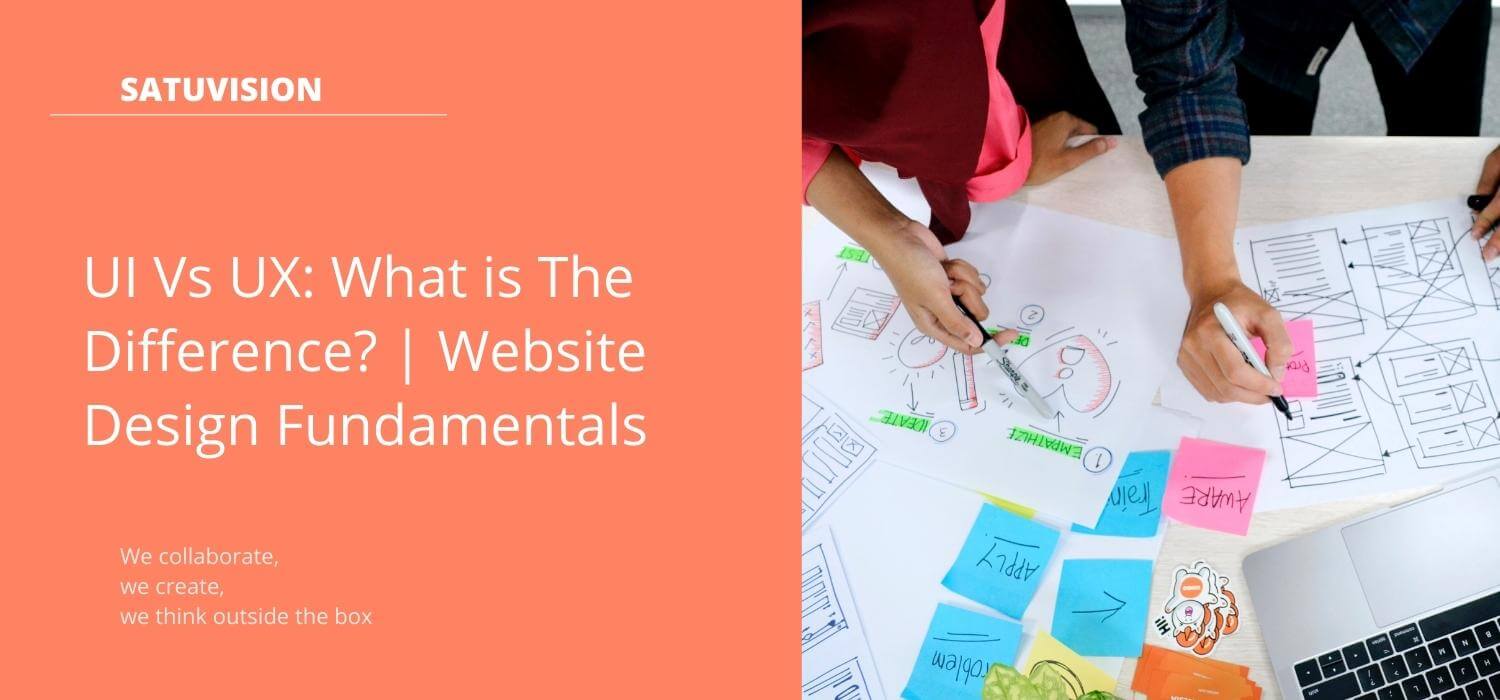There are a few well-known disputes in the world of design that are never completely resolved. One of the big ones is the difference between UI vs UX design.
At the most basic level, the user interface (UI) is a collection of screens, pages, and visual items such as buttons and icons that allow someone to interact with a product or service.
On the other hand, user experience (UX) is the internal experience that a person has while using every aspect of a company’s products and services.
It’s common for people to misuse these words interchangeably, or even mistakenly. If you’ve ever wondered, “What is UI, what is UX, and what’s the difference between them?” in this post we’ll dig a bit deeper into UI and UX to get a better understanding of the differences between them!
Quick View
The first thing is: What are UX and UI actually mean? Despite the fact that they’ve been around for decades, millennia, and have been defined by the tech industry as UX and UI design in theory for centuries, people you have eavesdropped on are discussing two professions that are different.
The phrase UX design refers to the notion of “user experience design,” whereas UI design means “user interface design.” Both elements are crucial to a product and work closely together. Despite their professional connection, the responsibilities are quite different. They refer to two very distinct areas of the product development process and design field.
Let’s start with the definitions of UX and UI before we look at the major distinctions between them!
What is UI?
The user interface (UI) is represented by a visual display of the design of a system. These views allow consumers to engage with a product.
The UI serves two purposes: It not only acts as a connection, but it also beautifies the appearance in order to improve user satisfaction. However, the UI must be not only attractive but also simple to use.
Button components, typographic icons, themes, layouts, animations that appear on goods, and other interactive visuals are some examples of UI elements. All of these UI elements are designed intended to be attractive and simple to use. As a result, consumers may enjoy and appreciate your product.
What does a UI designer do?
A UI designer job begins when a UX designer job ends—at the prototyping stage. They improve the wireframes with visual design to make them more usable, aesthetically appealing, and adaptable for a variety of screen sizes.
Now, let’s take a closer look at the typical tasks of a UI designer!
The product’s look and feel
- Design research: Research allows you to provide information about your users and competitors, as well as the newest design trends. This is critical to being inspired and building interfaces that are in line with consumer expectations.
- Visual design: UI designers are responsible of the product layout as well as all of the visual elements of the UI, such as colors, fonts, icons, buttons, and so on.
- Graphic development and branding: The UI design is influenced by the product’s brand overall positioning. Designers must find the proper balance between usefulness and consistently displaying the brand identity created by the marketing or creative team. As a result, UI design is closely linked with graphic design.
- Design systems: UI designers utilize style guides, pattern libraries, and components to describe how each component should appear (color, font, etc.) in order to ensure product and brand consistency.
Responsiveness and interactivity
- Responsive design: Interfaces must adapt to all types of devices, platforms, and screen sizes in terms of both form and function.
- Interactivity and animation: In order to create the interactivity of the interface, UI designers can use animations, changes in appearance or behavior, and other interactive elements.
- Prototyping: A UI prototype is a real-time representation of all UI components and design interactions. UI designers create prototypes to get a sense for how the product will work and to conduct user testing.

What is UX?
The design of a product through a user approach is known as user experience (UX). With this approach, you can create a product that fulfills the needs and wants of users.
When users use your product, a good UX design will provide users with a pleasant experience. When users use the product, they feel easy and comfortable.
Meanwhile, this UX component covers how the product’s features are delivered, design structure, product usage navigation, visual design elements, and all aspects of user interaction. UX is about branding, content, and copywriting that works for your target audience.
Let’s take a look at the typical tasks of a UX designer.
Research and strategy
- Plan: At the beginning of the UX design process, designers must establish a strategic plan that assures stakeholders are aligned and working towards the same objectives.
- User research: While most of us think of design as purely visual, a UX designer’s work is mostly conceptual problem-solving based on research and data.
- Information architecture: Information architecture (IA) is the process of arranging and labeling a website’s, app’s, or product’s content. The goal is to help users find information and accomplish their goals.
Wireframing and prototyping
- Creating the user flow: UX design is the process of speaking to users to determine their needs, followed by the creation of the optimal user flow that can assist them in accomplishing their tasks. The user journey is the focus which implies that a UX designer’s impact on how a completed product actually looks is limited.
- Wireframing: A wireframe is the basic structure of an interface—the bare essentials required to comprehend how a design will function on a functional level. It may be created digitally or drawn on paper.
- Testing: What is best way for a UX designer to determine if they’re doing their job correctly or not? Testing with real users. By conducting early testing during the design process with a rudimentary prototype or even a paper mockup. UX design requires gathering data from users in order to validate their concepts and assumptions.
- Analysis: UX designers collaborate with product managers and researchers to interpret the test findings and determine the next actions based on them.

What is the difference between UI & UX?
After knowing the meaning of UI and UX, do you now know the difference between the two? If not, don’t worry. In this section, we’ll describe what the true differences are between UI vs UX.
Design Goals
The basic difference between UI and UX is the design purpose. UI and UX design are focused on very different things. The aim of a UX design for a product is to improve the look of the product. While the UX design is focused on creating a pleasurable experience for the user whenever they use the product.
The focus of UI design is the look of the product, while the focus of UX design is the satisfaction of using the product.
Simply put, the user’s first impression of seeing your product will be influenced by the UI design. Meanwhile, UX affects how the UX when using the product.
Design Process
The design process itself varies depending on the goals. As a result, the UI and UX design processes are different.
Because the UX design process is focused on user experience, it is based on user research to generate goods that are liked and required by targeted users. A UX researcher is one of the many people involved in the process, which also goes through several phases and requires the input of numerous parties. A design sketch is created by the designer after doing research. It includes a wireframe and prototype.
Meanwhile, UI design also requires research. However, the research was designed to produce an attractive design that is in keeping with the concept. Here, UI designers must build a design model before they start work by creating a mockup.
Design Components
The UI design components are concerned with the beauty of the final product look. Colors, dynamic images and videos, typefaces, buttons, and other visual interactions are examples of UI components.
Meanwhile, the UX design component focuses on almost all aspects of a product, including features, design structure, and navigation. It also includes product design, interface display, copywriting, and branding. Teamwork is required to develop effective product designs since this involves all of these disciplines.
Tools Used
Different manufacturing processes require different tools. The beauty of images is important for UI designers. As a result, they require an application that allows them to create a detailed user interface design.
There are several UI design apps to choose from, such as Flinto, Principle, Frames X, Adobe Illustrator, and etc. The app includes a slew of tools to assist UI designers, including custom interaction icons, simple transitions, UI assets and kits, and more.
Meanwhile, UX designers require more design prototyping tools to obtain user feedback easily. Sketch, InVision, Figma, Adobe XD, and Axure are examples of design prototyping tools that help UX designers.
Collaboration tools, real-time editing, simple to test design, and so on are examples of some of the features that may be included. This feature will make it easier for UX designers to get feedback to produce user-friendly products.
Skills Required
Being a UI designer and UX designer requires its own skills. Graphic design, design branding, creative thinking, and convergent thinking are some of the required skills for a UI designer. UI designers must have the ability to design product displays that look attractive and simple to use in order for them to seem appealing and user-friendly.
A UX designer focuses on designing products with a user-in approach, making them simple to use. As a result, they must be trained to do research, develop analytical thinking, solve problems, think critically, and come up with innovative ideas.

Hopefully, we’ve given you all the information you need about UI vs UX to improve a good first impression on your business website. For advanced UI & UX strategies, please contact SATUVISION.






